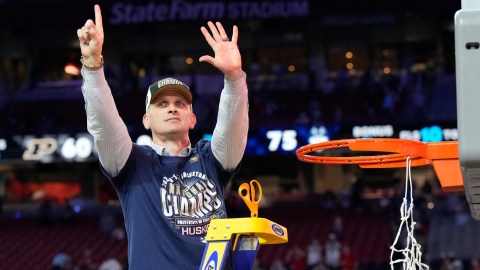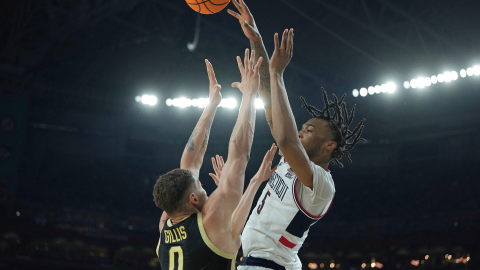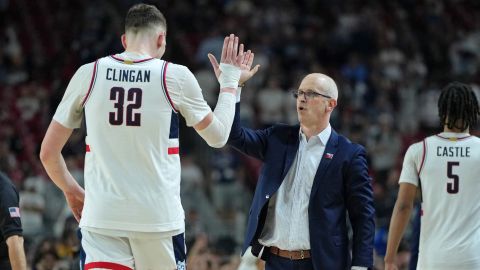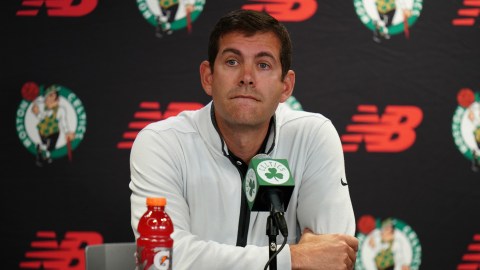How did Colorado not get in? Is the NCAA playing a sick joke on Seth Greenberg? How can Georgia be in, but not Alabama? What conferences are UAB and VCU even in?
Sunday’s uproar regarding the NCAA Tournament’s field of 68 teams couldn’t have been louder, and while there’s no denying that this year’s bracket is far from what we expected, the anger is being pointed in the wrong direction. The tournament snubs were understandable — the seeding isn’t.
At some point in the past five years, we’ve come to see Joe Lunardi‘s Bracketology not as a simple prediction of what the NCAA bracket could be, but a rubric for what it should be. Somehow, the notion that the actual field deviated from Bracketology has become more of an indictment of the field than of Lunardi’s guesstimate. In an effort to maintain Lunardi’s mystical brand equity, ESPN virulently defended his predictions that Colorado, Virginia Tech and St. Mary’s would get bids.
This all exists within the context of a tournament that has three new at-large bids, meaning that even if those three schools deserved to be in the field this year — and you can poke holes in those arguments — they wouldn’t have in the past. No such excuses, however, can explain what happened to the seeding.
When selection committee chair Gene Smith was interviewed on CBS following the release of the bracket, he spoke of how the committee spent most of its time debating the top lines of the bracket and the final bids — meaning that seeding in the middle of the field was given a more cursory treatment.
You could tell.
Quickly, rank these teams in your head: Marquette, Villanova, Georgetown, St. Johns, Cincinnati, West Virginia.
Give or take, based on how they’re playing right now, the ranking probably goes something like this: St. Johns, Cincinnati, West Virginia, Marquette, Georgetown, Villanova.
If you based your rankings on the team’s resume, you’d probably rank them: St. Johns, Cincy, Georgetown, WVU, Villanova, Marquette — or something close to it.
Add that up, and WVU receives the highest seed in the tournament, and Georgetown, potentially missing its best player and on an extended losing streak is given the same seed as St. Johns, a team with as many quality wins as anybody, and Villanova, a team that has been downright awful since January is ranked two lines ahead of Marquette, a team that has lost to one non-tournament team all year.
The nonsensical Big East seedings, though, are just the tip of the iceberg. The clearest illustration of bizarre placement in the bracket comes from the SEC, where Kentucky and Florida are somehow two lines apart.
Quickly, which team does your gut tell you is better?
Kentucky.
Who won the conference tournament?
Kentucky.
Who won the season series 2-1, with a total scoring margin of plus-20?
Kentucky.
Who lost by a combined five points to non-tournament teams?
Kentucky.
Who lost to the Jacksonville Dolphins?
Florida.
Who is given a two seed, and who got a four?
Florida, of course, got the two, and Kentucky the four.
Let’s keep in mind that the bracket is hypothetically constructed on an S-Curve, meaning that the worst one seed would play the best two seed, etc. Given an assumed Ohio State-Kansas-Pittsburgh-Duke ranking on the top line, this implies that Florida was the sixth overall seed, ahead of Notre Dame — arguably a one seed — and North Carolina. UK, on the other hand, would be ranked 16th-overall. Can you remotely argue that Florida is 10 spots better than Kentucky? Or that there are 15 teams better than Kentucky, which along with KU and UNC is clearly one of the three most talented teams in the country, and is peaking at the right time?
You can’t.
Then, there’s their conference-mate Vanderbilt, a five-seed that’s set to face off against Richmond — with just about everyone picking the Spiders. The 5-12 game may be a yearly rite, but never before this year did you ever look at your bracket and think that all of these games are complete pick-ems.
Well, one of the 12-seeds, Utah State, is a conference champion that went 29-3, has an RPI of 18 (which, ironically, would be what a five-seed should have) and has been a fixture in the dance for years.
Another 12-seed, the Spiders, won its conference tournament, beat Purdue, has improved as the season has gone on, and has just three losses to non-tournament teams. The other three 12’s are Memphis, another high-RPI conference winner with tournament pedigree, Clemson, a team that has been on a tear late in the season nearly beating UNC in the ACC semifinals, and UAB, a maligned at-large bid with a 9-5 road record, high RPI and Final Four coach.
Three of the four five-seeds that they’re up against (Arizona, Vandy and WVU) have shown very little that would inspire confidence in their tournament prospects, and the fourth, Kansas State, is capable of losing to anybody if Jacob Pullen doesn’t go off. If you were to go by the AP rankings, only Arizona would be a five, with KSU and WVU as six’s and Vandy a seven. Still, in their defense, the dropoff from four to a five in this tournament is massive, while the distinction between the five’s and seven’s is very minimal.
For example, both UCLA and Washington are sevens, and both beat Arizona recently. Of course, to complete the indictment of Pac-10 seeding one has to mention USC, who not only beat all three teams this season, but has the conference’s most impressive non-conference win against Texas. That, however, still adds up to an 11-seed for Southern Cal.
Three lines above USC on the bracket lie two tournament favorites, George Mason and Butler, but does either really have any right to be ranked ahead of all the 11 or 12 seeds? (Other than Virginia Commonwealth and UAB, of course.)
By RPI, Butler’s three best wins are against Cleveland State, Cleveland State and Cleveland State, the only top-50 RPI team that the Bulldogs have beaten. Mason, on the other hand, at least beat Harvard on their way to a 77th best non-conference RPI.
The hole-poking tour of the bracket could go on and on, but the reality is that the committee is forced to make decisions in a short amount of time, and the very top and very bottom of the bracket are the top priorities. Seeding in the middle is going to be flawed.
It may seem like a crazy suggestion, but wouldn’t a BCS-like ranking system combining human and computer polls do the best job of seeding? The flaw with the BCS as it pertains to college football, generally, isn’t how the system ranks the teams, but the fact that only the top two are included. The rankings seem pretty fair and, most importantly, we know how they work. They aren’t the concoction of some “committee” evaluating the teams in a short period of time.
College basketball is often praised among sports fans for having the most democratic of playoff systems, and it’s surely better to complain about the 69th and 70th best teams being left out of the postseason or whether or not a team deserves a five or seven seed in the bracket than to have to question which two teams should be given a chance at a national championship.
Still, the committee’s seeding was far beyond rationalization. Perhaps, they could use a more formulaic system to rationalize for them.
How should seeding be decided? Leave your thoughts below.
NESN’s college basketball coverage is presented by Bodog.net.



